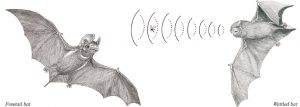August 2025 edition – Meatloaf would love these forest bats
Julimar Conservation and Forest Alliance
Max Howard
NINE bat species occur in the south-west of Western Australia and, of these, eight have
been recorded in the Julimar forest area.
The two species highlighted in this article are the White-striped Freetail Bat and the
Gould’s Wattled Bat.

Both of these species are found throughoutAustralia. The White-striped Freetail Bat is one of only a few bats in Australia whose calls are audible to the human ear.
Bats are a highly successful group of mammals having survived for over 50
million years.
They have a remarkable ability to adapt to their environment, so much so that they have
colonised every corner of the globe.
Bats are the only mammal that can fly, are long-lived (up to 20 years) and have a very slow reproduction rate, usually only one pup per year.
Bats are also clean and groom themselves meticulously.
To the best of my knowledge, the bats of Julimar Forest have not been subject to
detailed study. However, these bats would face similar threats to other bat species around the world.
These include threats from habitat destruction, fire, pesticide use and disturbance
at nest sites. Bats play an essential role in the functioning of the ecosystem.
Nectar eating bats are important pollinators of the many species of native flowering
plants on which they feed.
Insect eating bats can consume up to half their body weight per night.
They eat mosquitoes, midges, and other pest insects and are vital in controlling insect
numbers. Bats are nocturnal and have a unique echolocation system.
It is a complex biological sonar system that enables them to navigate and hunt prey
in the darkness.
They do this by emitting intense ultrasonic sound pulses which are in most cases
inaudible to humans.
With their sensitive ears they can interpret the echoes which bounce back.
This sensory mechanism is so efficient that objects as small as a midge or as fine as a
spider web can be detected by microbats.
Of the two bats depicted in this article the Gould’s Wattled Bat is by far the most
common in Australia.
It has a preference for tree hollows for roosting and nesting.
Consequently, the old growth trees found in the Julimar Forest are hugely important
for the continued existence to this species.
Information from this article was mainly gleaned from the brochure “Learn about
Bats” by Jo Burgar of Murdoch University.
The illustrations were provided by Rob Fleming of the WA Museum, which were in
the brochure of “Bats of Bungendore Park”.
Permission was obtained from theBungendore Park Management Committee
to use the illustrations.
